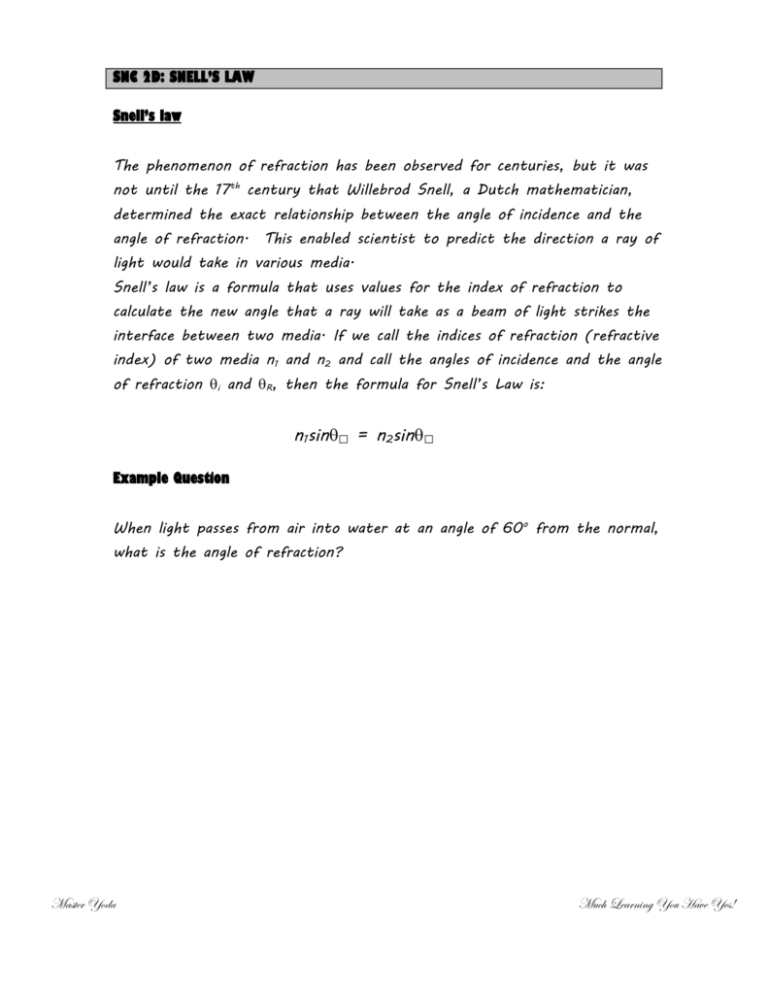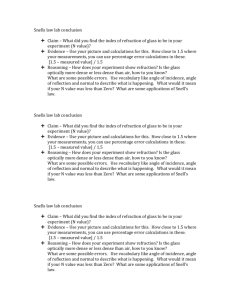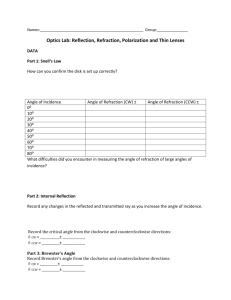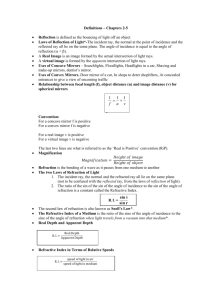Lesson 12 - Snell`s Law
advertisement

SNC 2D: SNELL’S LAW Snell’s law The phenomenon of refraction has been observed for centuries, but it was not until the 17th century that Willebrod Snell, a Dutch mathematician, determined the exact relationship between the angle of incidence and the angle of refraction. This enabled scientist to predict the direction a ray of light would take in various media. Snell’s law is a formula that uses values for the index of refraction to calculate the new angle that a ray will take as a beam of light strikes the interface between two media. If we call the indices of refraction (refractive index) of two media n1 and n2 and call the angles of incidence and the angle of refraction i and R, then the formula for Snell’s Law is: n1sin = n2sin Example Question When light passes from air into water at an angle of 60o from the normal, what is the angle of refraction? Master Yoda Much Learning You Have Yes! Total Internal Reflection When light travels from one medium into another, some of the light is reflected and some is refracted. Light can either speed up or slowdown as it passes from one medium to another. When light travels from air into water it slows down. This results in the light bending towards the normal. Master Yoda Much Learning You Have Yes! Light however, bends away from the normal when it speeds up at the boundary of two media. This occurs when light travels from water to air. The angle of incidence i and the angel of refraction R are measured from the normal. Master Yoda Much Learning You Have Yes! As the angle of incidence increases, the angle of refraction increases, eventually reaching a maximum of 90o. Beyond this point, refraction ceases, and all the incident light is reflected, at the boundary, back into the optically denser medium. This is called total internal reflection. Then angle of incidence that creates an angle of refraction of 90o is called the critical angle. This only happens when light leaves a medium and increases speed. Total internal reflection occurs when: a) light is travelling more slowly in the first medium than in the second. b) The angle of incidence is large enough that no refraction occurs in the second medium. Instead the ray is reflected back into the first medium. Water has a critical angle of 48.8o. This means than an angle of incidence greater than 48.8o would result I total internal reflection in the water. The index of refraction for a substance conveys information about the speed in which light travels through that substance. The greater the value of the index of refraction the slower light travels through that substance. Therefore if n1 > n2 light bends away from the normal because it increases Master Yoda Much Learning You Have Yes! speed as it passes from the first medium to the second. If n2 > n1 then light bends towards the normal as it passes from n2 to n1 Example Question SNC 2D: Snell’s Law Practice Problems For questions one through three assume light is entering AIR. 1. What is the critical angle in flint glass when light passes from flint glass into air? 2. If the index of refraction for water is 1.33, what is the critical angle for water? 3. The critical angle for a medium is 40.5o. What is the index of refraction of the medium? 4. Light travels from crown glass into water. The angle of incidence in crown glass is 40o. What is the angle of refraction in water? 5. If the index of refraction for a diamond is 2.42, what will be the angle of refraction in diamond for an angle of incidence in water, of 600? Master Yoda Much Learning You Have Yes! 6. A ray of light passes from water into carbon disulphide (1.63) with an angle of incidence of 30o. What is the angle of refraction in the carbon disulphide? 7. A diver shines her flashlight upward from beneath the water at an angle of 30o to the vertical. At what angle to the vertical does the beam of light emerge from the water? 8. A ray of light passes from air into water at an angle of incidence of 50o. What is the angle of refraction? 9. One ray of light in air strikes a diamond and another strikes a piece of quartz, in each case at an angle of incidence of 40o. What is the difference between the angle of refraction? 10. An underwater swimmer looks up towards the surface of the water on a line of sight that makes an angle of 25o with a normal to the surface of the water. What is the angle of incidence in air for the light rays that enter the swimmer’s eye? 11. A beam of light is aimed from air into three different materials, X, Y, Z, such that the angle of incidence in each case is 56o. Determine the index of refraction of X, Y, Z, given that the angles of refraction are 26o, 40o, and 30o respectively. What is each of the substances? Answers: 38o, 49o, 1.54, 47o, 28o, 24o, 42o, 35o, 11o, 34o, 1.89, 1.29, 1.66 Do answers for questions 1 – 3 Master Yoda Much Learning You Have Yes! SNC 2D: Snell’s Law Problems 2 Common Indices i) Air or vacuum: 1.00. ii) Water: 1.33 iii) CR39: 1.498 iv) Crown Glass: 1.523 v) Barium Glass: 1.60 vi) Flint Glass: 1.70 vii) viii) Polycarbonate: 1.586 Diamond: 2.45 1. A ray of light travelling from air into crown glass strikes the surface at an angle of 30o. What will the angle of refraction be? 2. What is the index of refraction of a refractive medium if the angle of incidence in air is 30o and the angle of refraction is 15o? 3. What is the index of refraction of a refractive medium if the angle of incidence in air is 40o and the angle of refraction is 29o? 4. What is the index of refraction of a liquid if the angle of incidence in air is 35o and the angle of refraction is 14o? 5. If the angle of incidence of light travelling through air, striking water, is 30o, what is the angle of refraction? Master Yoda Much Learning You Have Yes! 6. If the index of refraction for a certain glass is 1.50, and the angle of refraction is 15o for a ray of light travelling from air, what is the angle o incidence? 7. A light ray moving through CR39 at an angle of 49o exits into another medium at an angle of 41o. What is the index of the second medium? 8. What is the angle of incidence for a light ray travelling from water into flint glass, if the angle of refraction is 30o? 9. What is the refractive medium if a ray coming from air at an angle of incidence of 50o is refracted through an angle of 35o? Answer: 19o, 1.93, 1.33, 2.37, 22o, 23o, 1.72, 40o, 1.34 Master Yoda Much Learning You Have Yes!








